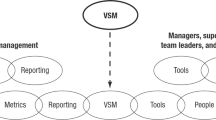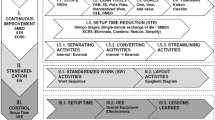Abstract
Flexibility and responsiveness to customer demands are very important for success. Generally additional time is needed for setup caused by poor design of equipment. At this point the terms continuous process improvement and SMED (single minute exchange of dies) as an approach of lean manufacturing come into play. A lean manufacturing system is part of corporate culture, like tools and approaches. In this research work, the process capability analysis technique is implemented by using MINITAB14 software to investigate the relation between SMED methodology and equipment design. The index Cpk has been used in this application study to provide a quantitative measurement of the equipment design by applying the SMED methodology in automobile manufacturing. The results of this research study indicated that SMED in other words “quick changeover” is still a suitable method not only for manufacturing improvement but also for equipment/die design development.
Similar content being viewed by others
References
Van Goubergen D (2000) Set-up reduction as an organization-wide problem. Proceeding of the IIE Solutions 2000, Cleveland, Ohio
Spann MS, Adams M, Rahman M, Czarnecki H, Schroer BJ (1999) Transferring lean manufacturing to small manufacturers: The role of NIST-MEP. University of Alabama in Huntsville
Shingo S (1985) A revolution in manufacturing, the SMED system. Productivity Press
Asano T (2002) Lean manufacturing as lean thinking Japanese definition, JMA Consultants America, Inc.
Womack JP, Jones DT (1997) Lean thinking. Simon and Schuster, London
Garcia JAM, Pardo del Val M, Bonavia Martin T (2006) The impact of training and ad hoc teams in industrial settings. MSEM 1(2):137–147
Cakmakci M, Karasu MK (2007) Set-up time reduction process and integrated predetermined time system MTM-UAS: A study of application in a large size company of automobile industry. Int J Adv Manuf Technol 33(3–4):334–344
Eti MC, Ogaji SOT, Robert SD (2004) Implementing total productive maintenance in Nigerian manufacturing industries. Appl Energy 79:385–401
Chand G, Shirvani B (2000) Implementation of TPM in cellular manufacture. J Mater Process Technol 103:149–154
Sun H, Yam R, Wai-Keung NG (2003) The implementation and evaluation of Total Productive Maintenance (TPM)—an action case study in a Hong Kong manufacturing company. Int J Adv Manuf Technol 22:224–228
Prado JC (2001) Beyond quality circles and improvement teams. TQM 12(6):789–798
Bamber L, Dale BG (2000) Lean production: A study of application in a traditional manufacturing environment. Prod Plan Control 11(3):291–298
McAdam R, McGeough F (2000) Implementing total productive maintenance in multi-union manufacturing organizations: overcoming job demarcation. TQM 11(2):187–197
Gilmore M, Smith DJ (1996) Set-up reduction in pharmaceutical manufacturing: an action research study. Int J Oper Prod Man 16(3):4–17
Moxham C, Greatbanks R (2001) Prerequisites for the implementation of the SMED methodology: A study in a textile processing environment. Int J Qual Reliab Man 18(4):404–414
McIntosh R, Culley S, Gest G, Mileham T, Owen G (1996) An assessment of the role of design in the improvement of changeover performance. Int J Oper Prod Man 16(9):5–22
Van Goubergen D, Van Landeghem H (2002) Reducing setup times of manufacturing lines. Proceeding of International Conference on Flexible Automation and Intelligent Manufacturing, Dresden, Germany
Van Goubergen D, Van Landeghem H (2002) Rules for integrating fast changeover capabilities into new equipment design. Robot Comput Integr Manuf 18:205–214
Mileham AR, Culley SJ, Owen GW, McIntosh RI (1999) Rapid Changeover– a pre-requisite for responsive manufacture. Int J Prod Man 19(8):785–796
Patel S, Shaw P, Dale BG (2001) Set-up time reduction and mistake proofing methods: A study of application in a small company. Bus Process Man J 7(1):65–75
Auto/Steel Partnership Program (1999) Stamping process variation: An analysis of stamping process capability and implications for design, die tryout and process control. Final Report, Southfield
Montgomery DC (1997) Introduction to statistical quality control. John Wiley and Sons Inc., New York
Hitch KL, Tong lI (2005) Incorporating process capability index and quality loss function into analyzing the process capability for qualitative data. Int J Adv Manuf Technol (online published)
Pearn WL, Chen KS (1997) Capability indices for non-normal distributions with an application in electrolytic capacitor manufacturing. Microelectron Reliab 37(12):1853–1858
Lin H-C (2005) Using normal approximation for calculating the p-value in assessing process capability index Cpk. Int J Adv Manuf Technol 25:160–166
Kane VE (1986) Process capability indices. J Qual Technol 18:805–820
Cakmakci M, Nasirlialp M (2005) Process capability analysis for normal and non-normal distribution with an application in advanced manufacturing. Proceeding of the 3th International Congress of Precision Machining, Vienna, Austria
Lin H-C (2004) The measurement of a process capability for folded normal process data. Int J Adv Manuf Technol 24:223–228
Sentürk S, Yazici B (2001) Six sigma program and an application, Exchange of Technology and Know-how, New Techniques for Statistics EKT 2001. Proceeding of the International Seminar of European Commission, Crete, Greece
Durman MBS, Pakdil F (2005) Istatiksel proses control uygulamalari icin bir system tasarimi. Proceeding, IIV. Ulusal Ekonometri ve Istatistik Sempozyumu, Istanbul, Turkey
Author information
Authors and Affiliations
Corresponding author
Rights and permissions
About this article
Cite this article
Cakmakci, M. Process improvement: performance analysis of the setup time reduction-SMED in the automobile industry. Int J Adv Manuf Technol 41, 168–179 (2009). https://doi.org/10.1007/s00170-008-1434-4
Received:
Accepted:
Published:
Issue Date:
DOI: https://doi.org/10.1007/s00170-008-1434-4




